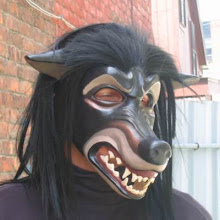


As I've been casting different masks using papier mache strips, I've been noticing that the masks' overall shape has a lot do do with the degree to which they try to warp during drying.
Above I have posted pics of the backs and insides of a "Rip" mask, a "Rival" horse mask, and a little eyeball mask.
The "Rip" mask really wants to warp during drying. I believe it's because the mask has an overall cylindrical/conical shape with a wedge cut out of the bottom. I think papier mache strips tend to want to pull along curved surfaces as they dry. There is nothing to stop that pull along the bottom of this mask, so it warps. You can see that I wound up putting a triangular "plug" in the jaw to prevent this.
The horse mask "Rival" warps only a tiny bit during drying. I believe this is because the cylindrical/conical part of this mask is closed, and the open part on the bottom is circular. As the papier mache strips dry and try to pull, there isn't anywhere that they can move to. All the available space is filled.
The little eyeball mask does not warp at all during drying. It doesn't have much of a curved shape to it, and besides, it has 1/4" lip at a roughly 90 degree angle to the mask all around the edges. I believe the pull of the papier mache strips on this little lip cancel out the pull of those on main mask as they dry. This lip, while a tremendous pain in the butt to cast, also adds a lot of strength to the edges of the mask, which also helps to reduce the number of layers of paper I need to use.
In general, the more details a mask has (folds, wrinkles, bone structures, etc) the less likely it is to warp, as the details interrupt the pull of the strips as they dry. Conversely a smooth mask is more likely to warp, as little interrupts that pull.
Technicalities... but let me tell you, a warped mask is no fun!!!



No comments:
Post a Comment